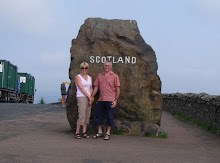The Orkneys seem much more Scandinavian than Scottish. Apparently Orcadians spoke Norn, a Scandinavian language, not Gaelic, until three centuries ago and now speak English with an accent that Nigel thinks sounds like Welsh. A local lady told us that they were as Scottish as they felt like being; they are Scottish when the national football team is winning for example. The climate is mild (they rarely have frosts, the same lady told us, and feel ill when temperatures are higher than seventy) and the land is fertile for farming.
We sailed to Stromness in Mainland Orkney on the MV Hamnavoe- an hour-and-a-half journey that takes you close to the sea stack, and star of television climbs, the Old Man of Hoy. Stromness is a picturesque town of stone-paved streets and grey houses with thick walls, sometimes built so close together and with gable ends to the street that you would think inhabitants could join hands from their windows. We are camped on the Point of Ness, just outside the town, where boats pass our tent on their way into the harbour. The Mainland curves round the relatively sheltered waters of Scapa Flow where the German fleet was scuttled in 1919 and where the warships of the Royal Navy were anchored in the first half of the twentieth century. Now it is oil tankers that lie along the horizon, on their way to the Flotta refinery.
History is visible everywhere on the island. Children here must grow up with cairns and stone circles as their adventure playgrounds. Headlines on Radio Orkney announce another new find from the Neolithic. Yesterday we visited Skara Brae, a 5000 year old Neolithic village, older than Stonehenge or the Pyramids. Here you can see how, judging from their homes and possessions, 5000 years ago people were pretty much like us. You can see their beds and their dressers, their dice and their bracelets. At twilight, we went to Maes Howe, a prehistoric chambered cairn. At the winter solstice the pink rays of the setting sun beam onto the orange sandstone of the back chamber. This event is now shown annually on webcam- and Nigel and I will be watching this December! 4000 years after it was built, a party of Vikings sheltered from a snowstorm inside the cairn and graffitied the walls with their runes. You can almost hear them speaking in their graffiti: “Thor and I bedded Helga” and “I am carving this high up” are amongst their legacy.
We are fascinated by the Orkneys and expect to be here a while.
Scapa Flow paddle.
The forecast yesterday for today’s weather promised to be better than it has been for a while and, for the first time this trip, sunshine woke us early enough to listen to the shipping forecast broadcast by the Shetland coastguard at 07:10. with a view to a sea paddle. “Wind 3-4 occasionally 5 later, sea state slight to moderate occasionally rough”. This is for the 12 miles inshore around Orkney. We have found that in the shelter of the land the conditions are usually better than broadcast so we decided to drive to Houton Head and paddle to Scapa Bay, some 10 miles to the east. The wind was from the south, so on shore, but no shelter, but as we unloaded the boats and made ready to launch the sea looked calm enough and there are several bays along the route which could potentially be used as get-outs. We launched just before 10:00 am and had a pleasant paddle to Swanbister bay where we stopped for a drink and a bite to eat. On the way we saw many seals, they were inquisitive and playful whilst keeping a safe distance from us. It was around about here that the wind and the sea started to pick up a bit, so we launched once more and headed off round the next peninsula (appropriately named “The Lash”!) this is where the sea got interesting!! We decided to pull into the next bay, Waulkmill bay, which offered a get out with a road nearby. Given hindsight maybe we should have ended the journey there. However we decided to press on round the next headland which marked the start of the final stretch to Scapa Bay, but offered no further realistic get-outs, the cliffs being high and sheer. This final part of the paddle was very challenging, the seas were building moderate to rough and the following/side wind was 4-5. each promontory that we had to round seemed to throw up bigger wave sets than the last, making the final 4 miles quite tense. It was a relief to finally see the beach at the distant end of Scapa bay – 1 mile away, this last mile taking for ever to complete. Finally at about half past one we surfed onto the beach, I (Nigel) jumped out of my kayak declaring “we’re alive”!!! this was a paddle we will remember but not one I would rush to do again.
A bus with a message!!

Tuesday, 1 September 2009
Subscribe to:
Post Comments (Atom)

No comments:
Post a Comment